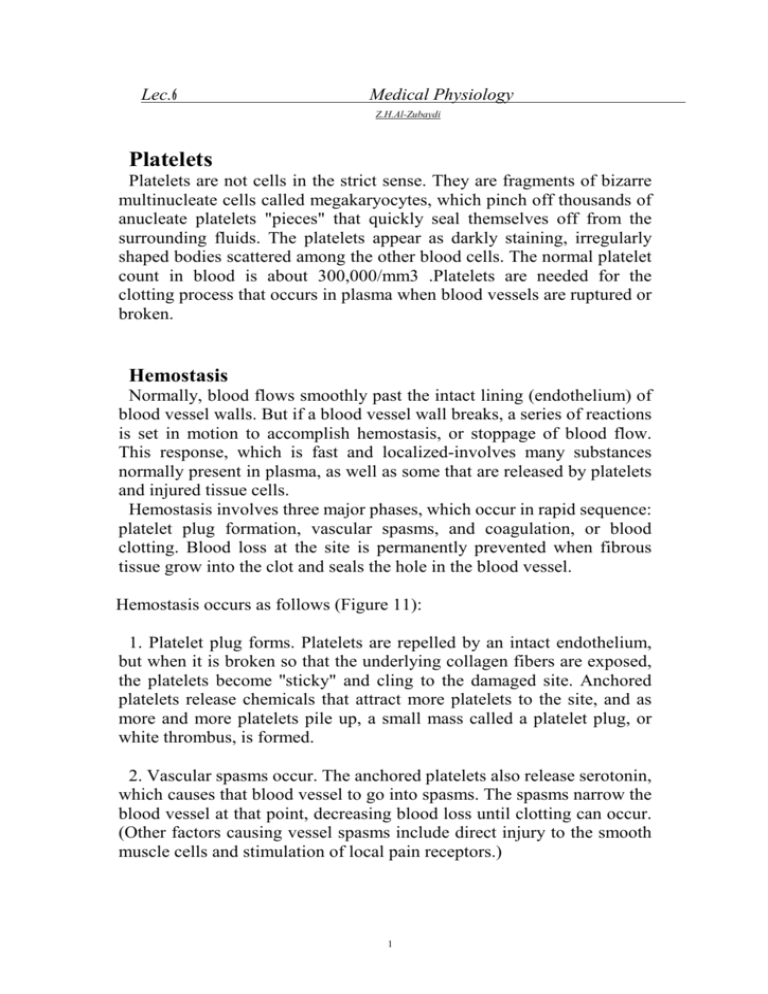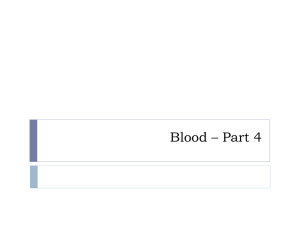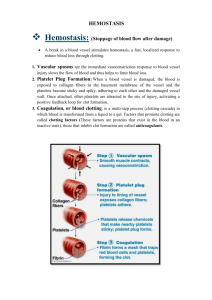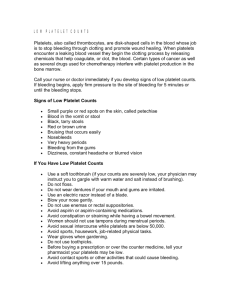Platelets
advertisement

Lec.6 Medical Physiology Z.H.Al-Zubaydi Platelets Platelets are not cells in the strict sense. They are fragments of bizarre multinucleate cells called megakaryocytes, which pinch off thousands of anucleate platelets "pieces" that quickly seal themselves off from the surrounding fluids. The platelets appear as darkly staining, irregularly shaped bodies scattered among the other blood cells. The normal platelet count in blood is about 300,000/mm3 .Platelets are needed for the clotting process that occurs in plasma when blood vessels are ruptured or broken. Hemostasis Normally, blood flows smoothly past the intact lining (endothelium) of blood vessel walls. But if a blood vessel wall breaks, a series of reactions is set in motion to accomplish hemostasis, or stoppage of blood flow. This response, which is fast and localized-involves many substances normally present in plasma, as well as some that are released by platelets and injured tissue cells. Hemostasis involves three major phases, which occur in rapid sequence: platelet plug formation, vascular spasms, and coagulation, or blood clotting. Blood loss at the site is permanently prevented when fibrous tissue grow into the clot and seals the hole in the blood vessel. Hemostasis occurs as follows (Figure 11): 1. Platelet plug forms. Platelets are repelled by an intact endothelium, but when it is broken so that the underlying collagen fibers are exposed, the platelets become ''sticky" and cling to the damaged site. Anchored platelets release chemicals that attract more platelets to the site, and as more and more platelets pile up, a small mass called a platelet plug, or white thrombus, is formed. 2. Vascular spasms occur. The anchored platelets also release serotonin, which causes that blood vessel to go into spasms. The spasms narrow the blood vessel at that point, decreasing blood loss until clotting can occur. (Other factors causing vessel spasms include direct injury to the smooth muscle cells and stimulation of local pain receptors.) 1 3. Coagulation events occur. a. At the same time, the injured tissues are releasing tissue factor (TF), a substance that plays an important role in clotting. b. PF3, a phospholipid that coats the surfaces of the platelets, interacts with TF, vitamin K and other blood protein clotting factors, and calcium ions (Ca2+) to form an activator that triggers the clotting cascade. c. This prothrombin activator converts prothrombin, present in the plasma, to thrombin, an enzyme. d. Thrombin then joins soluble fibrinogen proteins into long hair like molecules of insoluble fibrin, which forms a mesh-work that traps the RBCs and forms the basis of the clot. Within the hour, the clot begins to retract, squeezing serum (plasma minus the clotting proteins) from the mass and pulling the ruptured edges of the blood vessel closer together. Normally, blood clots within 3 to 6 minutes. As rule, once the clotting cascade has started, the triggering factors are rapidly inactivated to prevent widespread clotting ("solid blood"). Eventually, the endothelium regenerates, and the clot is broken down. Once these events of the clotting cascade were understood, it became clear that placing a sterile gauze over a cut or applying pressure to a wound would speed up the clotting process. The gauze provides a rough surface to which the platelets can adhere, and the pressure fractures cells, increasing the release of tissue factor locally. Disorders of Hemostasis The two major disorders of hemostasis— undesirable clot formation and bleeding disorders— are at opposite poles. Undesirable Clotting Despite the body's safeguards against abnormal clotting, undesirable clots sometimes form in intact blood vessels, particularly in the legs. A clot that develops and persists in an unbroken blood vessel is called a thrombus. If large enough, it may prevent blood flow to the cells beyond the blockage. For example, if a thrombus forms in the blood vessels serving the heart (coronary thrombosis), the consequences may be death of heart muscle and a fatal heart attack. If a thrombus breaks away from the vessel wall and floats freely in the bloodstream, it becomes an embolus. An embolus is usually no problem unless or until it lodges in a blood vessel too narrow for it to pass through. For example, a cerebral embolus may cause a stroke. Undesirable clotting may be caused by anything that roughens the 2 endothelium of a blood vessel and encourages clinging of platelets, such as severe burns, physical blows, or an accumulation of fatty material. Slowly flowing blood, or blood pooling, is another risk factor, especially in immobilized patients. In this case, clotting factors are not washed away as usual and accumulate so that clot formation becomes possible. A number of anticoagulants, most importantly aspirin, heparin, and dicumarol, are used clinically for thrombus-prone patients. Bleeding Disorders The most common causes of abnormal bleeding are platelet deficiency (thrombocytopenia) and deficits of some of the clotting factors, such as might result from impaired liver function or certain genetic conditions. Thrombocytopenia results from an insufficient number of circulating platelets. Even normal movements cause spontaneous bleeding from small blood vessels. This is evidenced by many small purplish blotches, called petechiae, on the skin. It can arise from any condition that suppresses myeloid tissue, such as bone marrow cancer, radiation, or certain drugs. When the liver is unable to synthesize its usual supply of clotting factors, abnormal and often severe bleeding episodes occur. If vitamin K (needed by the liver cells to produce the clotting factors) is deficient, the problem is easily corrected with vitamin K supplements. However, when liver function is severely impaired (as in hepatitis and cirrhosis), only whole blood transfusions are helpful. The term hemophilia applies to several different hereditary bleeding disorders that result from a lack of any of the factors needed for clotting. Commonly called "bleeder's disease," the hemophilias have similar signs and symptoms that begin early in life. Even minor tissue trauma results in prolonged bleeding and can be life-threatening. Repeated bleeding into joints causes them to become disabled and painful. When a bleeding episode occurs, hemophiliacs are given a transfusion of fresh plasma or injections of the purified clotting factor they lack. Because hemophiliacs are absolutely dependent on one or the other of these therapies, some have become the victims of blood-transmitted viral diseases such as hepatitis and AIDS. (AIDS, acquired immunodeficiency syndrome, is a condition of depressed immunity) These problems have been largely 3 resolved because of the availability of genetically engineered clotting factors. 4 Figure (11) :Hemostasis 5










